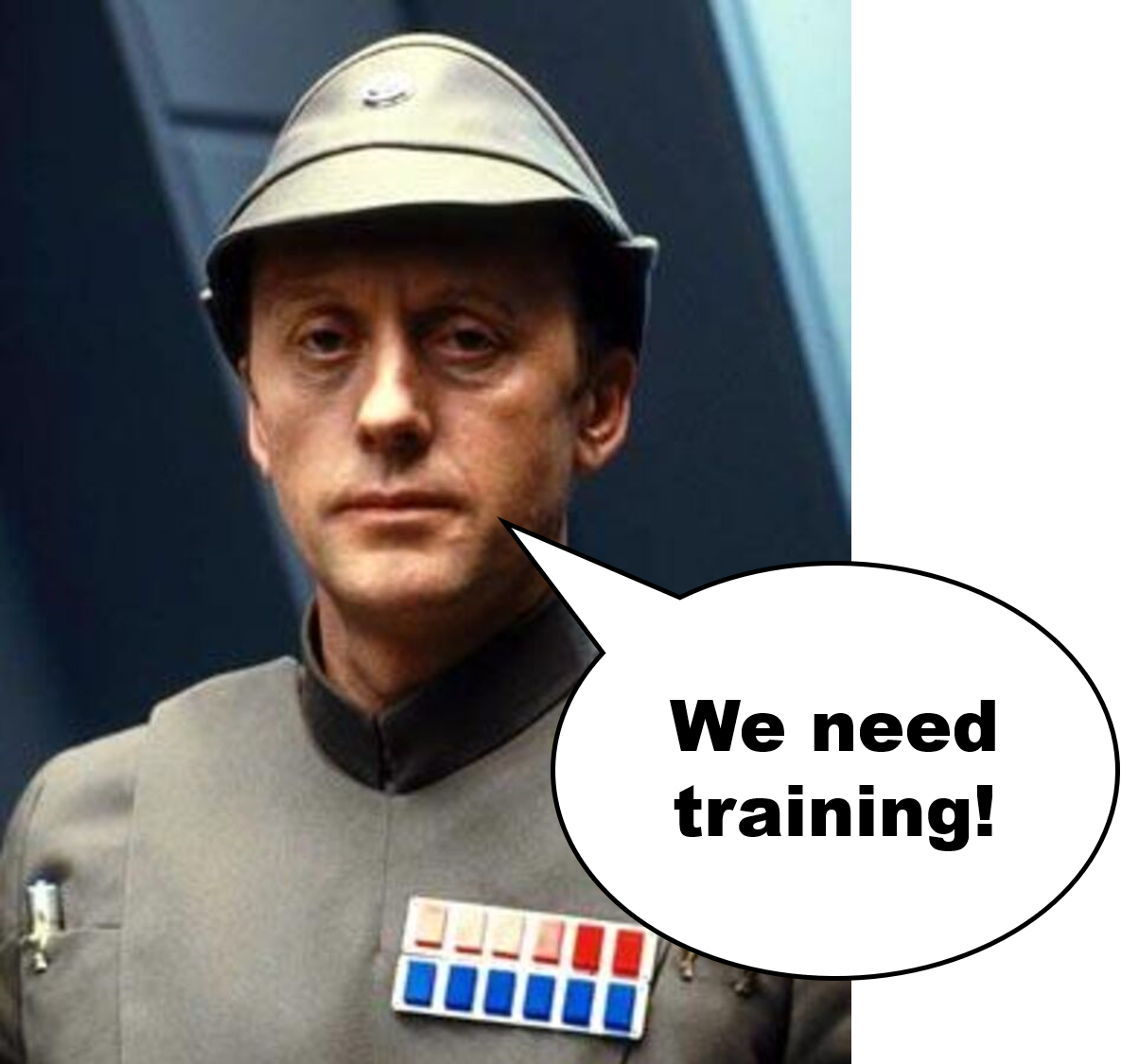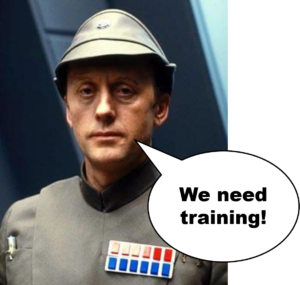
Recently, in a meeting, a colleague introduced me with the line “he’s our instructional designer, he makes things look pretty.” Now, in fairness, that can be a significant part of what I do sometimes – where I take god-awful “wall of text” slides from a subject matter expert and try to make them more palatable to an audience of humans. But surely my colleague knows the job of an instructional designer involves more than that…doesn’t she???
There is a lot of information out there about instructional design and being an instructional designer. A lot of it is good and quite a bit of it is confusing. To be honest, even I get confused. So, what is instructional design? Let’s see if we can make some sense out of it shall we?
The simplest way I can describe instructional design is that it is the … well…. it’s the design of the instruction. There! Now you know!
If you think about any type of learning – classroom, online, corporate training, elearning, video course, etc… It doesn’t just magically create itself. Someone has to plan it out before it gets created or delivered. The process of planning it out is what I would call instructional design with said planner being the instructional designer.
Let’s look at an example. Let’s say Admiral Piett decides some training needs to be developed to help stormtroopers be better shots. (As the title says, I’m a Star Wars nerd!)

Ideally, as the instructional designer, you would start with some kind of analysis of the identified training need. A lot of times, training is thrown out as a solution when there is actually some other issue taking place. Part of the analysis is to determine if training really can help or if something else is causing the stormtroopers to be terrible shots.
You would probably talk to some stormtroopers (the audience) as well as their commanding officers. You might also watch the first scene of Star Wars Episode IV: A New Hope where, clearly, these guys couldn’t hit the side of a barn.
There are a lot of things you could uncover through the analysis. Maybe the Empire cheaped out on weapons so when a stormtrooper is aiming, the inferior targeting system is off. Maybe the helmets obscure the vision of the stormtrooper enough to make targeting all but impossible. Maybe something went wrong in the cloning process that affected their ability to aim properly. So, it may not be a training issue at all. It may be that the Empire needs to pony up and get better weapons or redesign the helmets or pay a visit to Kamino to see what’s up with the defective clones. Or, you may indeed discover that training CAN help the situation in which case you would start the process of DESIGNING the training.
Where do you even start? Typically, you will want to identify the learning objectives. What are learning objectives? Basically, they are what you want the learners to be able to do as a result of your training. So, you might say “be a better shot” is the learning objective. That’s a start but it’s pretty vague. What do we mean by “be a better shot”? Do we mean hitting a womp rat from 20 feet away? Getting closer. That’s more specific but are womp rats really the concern? No, it’s the Rebel scum! Although, womp rats are pretty annoying too so let’s just use the generic “target”. And then the objective might be “Using an E-11 blaster, the learner will be able to hit a moving target from twenty feet away.” That’s better. You really want your objective(s) to be both specific and measurable. Otherwise, how do you know if the training worked?
Using the learning objectives as your guide, you would next start to figure out what to include in your training. Depending on the type of training, you may or may not have first hand knowledge of the topic. Are you a former stormtrooper who got promoted to instructional designer? If so, you may already have a lot of good knowledge about the E-11 blaster and how to use it. What if you’ve never been a stormtrooper and have never even held an E-11 blaster? What then? In that case, you would definitely want to talk to some SMEs or “Subject Matter Experts”. Ideally, you would get the names (or alpha-numeric identifiers) of a stormtrooper or two who actually ARE good shots. Like that one who hit Leia with the blaster in stun mode. He might be a good candidate. If you’re not sure, you could ask Admiral Piett or another commanding officer for some recommendations.
Once you’ve identified some SMEs, you would interview them to find out what they do to hit their targets. You might also observe them to see first hand. Is there a particular way they hold the blaster? Is there a setting on the blaster that helps with aim? You will want to take note of anything relevant to include in the training.
Now that you’ve gathered all of the information you need, it’s time to put together your content for training. As the instructional designer, you have to filter out the “nice to know” from the “need to know”. This can be challenging, especially when the SMEs or the commanding officers want you to cram everything you can into the training. “We should tell them where the E-11 blaster is manufactured.” “Oh, they need to know the procedure for how to trade out their blaster” “It’s important that they clean the blaster after each mission”.
When determining what to include in the training, it’s best to go back to your learning objectives as your source of truth. Does knowing where the E-11 is manufactured help with hitting a target from 20 feet? Probably not. Does cleaning it regularly? Possibly. You may find out in your interviews that dirty blasters aren’t as accurate so cleaning is an essential part to improving one’s aim. In that case, you would probably add that the learner will be able to clean the E-11 blaster as another learning objective.
As you organize the content and determine what you are going to include, you will probably also start to have a good idea of HOW you think you will want the training delivered. Is this training that can be delivered online? Will it be a video? Classroom instruction? There are a lot of ways you can go. In a perfect world, you would match the type of instruction to what you believe will be best for the learners.
For this example, let’s say you decide that this will be a half day, in person training session. You want Admiral Piett to kick it off to help demonstrate the importance of the training. Then, you’ll have one of the SME’s demonstrate his blaster techniques by actually shooting at a moving target. It’d be cool if you could use a captured Rebel spy but most likely it will be a target droid of some kind. Then, there will be a cleaning demo followed by the learners cleaning their blasters. And finally, their turn to practice blasting Rebel spies…er…uh…I mean target droids.
Something to keep in mind as you map all this out is to always be flexible. Sometimes, you have a great idea for your training and you actually get to design it the way you want and it gets delivered that way. Oftentimes, though, due to a variety of reasons, you don’t. It could be resources (training room isn’t big enough), budget (target droids are too expensive), scheduling (Piett isn’t available for the training), galactic pandemic (even galaxies far away can’t avoid COVID!). You get the picture.
Once you sort all that out, it’s time to create the training materials. You will have determined what needs to be created as part of the development you did earlier. Assuming the half day, in person training scenario, your training materials may be as follows:
- Facilitator guide/outline
- Participant workbook/handouts
- PowerPoint presentation
- Piett welcome video
In many cases, the instructional designer is the one creating these materials using various tools. Sometimes, though, depending on the makeup of the team, there may be graphic designers, video editors and others who can assist.
When everything is created and ready to go, the next phase would be the actual scheduling and delivery of the training. Typically, there is a training coordinator or project manager who handles the scheduling/logistics with the delivery being handled by a trainer or facilitator. This can vary widely depending on the company or department. It could be that you are responsible for both designing and delivering the training. If you are only responsible for the instructional design part, then, the next step for you would be to observe the training.
Training observation is very beneficial to the instructional designer. This is where you get to see your vision come to life. This can be very exciting and fulfilling when the class goes well and the learners have really embraced the training. It can also be a bit of a bummer when the activity you thought would be so awesome totally bombs.
Regardless of how well things go or how bad something flops, you always learn something that you can use to improve the training for next time. For example, you might notice the stormtroopers giving each other some extra pointers on effective cleaning. These might be ideas worth including in the training for next time.
A final step you may be involved with as the instructional designer is the evaluation of the training. At a minimum, there is usually some kind of poll or list of questions given to the learners at the end of the training so they can give feedback. Just like with observing the training, this feedback can help improve future training.
That is one level of evaluation. Again, depending on the company, situation, time, there may be further levels of evaluation. For example, evaluation where the accuracy is actually measured out in the field might occur. This would be VERY beneficial to show actual results of your training program. It might even save you from a Force choke by a certain Sith Lord…
This is just one example of how a project might go for an instructional designer. Other projects might involve building e-learning or training via webinar or maybe even using virtual reality. There is endless variety which is why I love this field and why I encourage other creative types to check it out.
I hope this article helped your understanding of instructional design along with what an instructional designer does. Do you have questions? Suggestions for other articles? Let me know in the Comments section! Oh, and…May The Force Be With You!